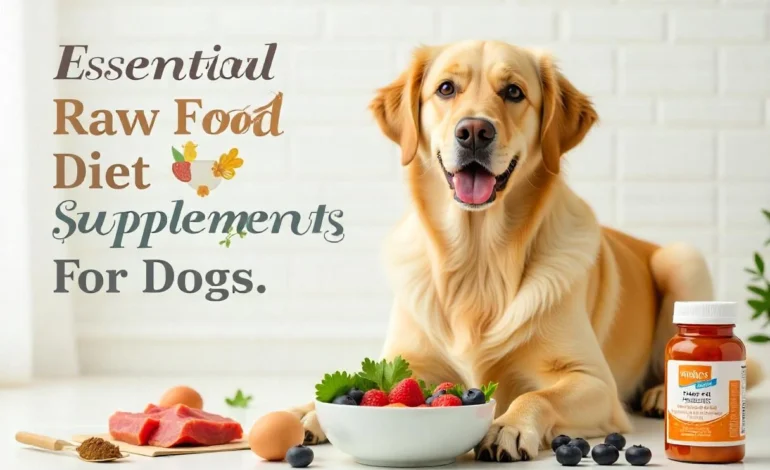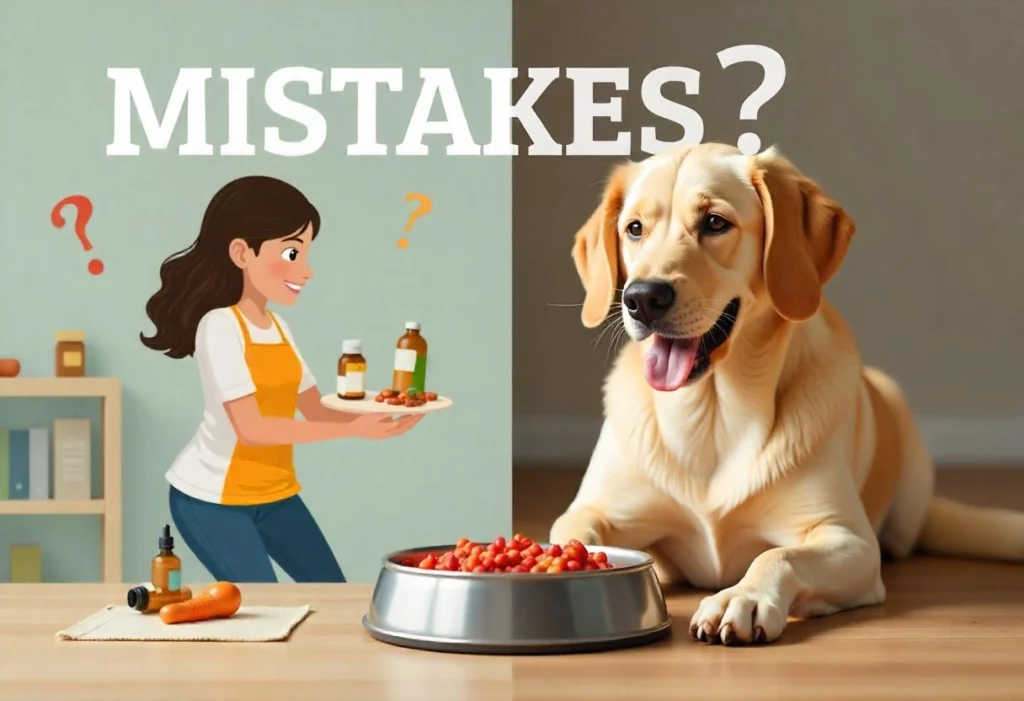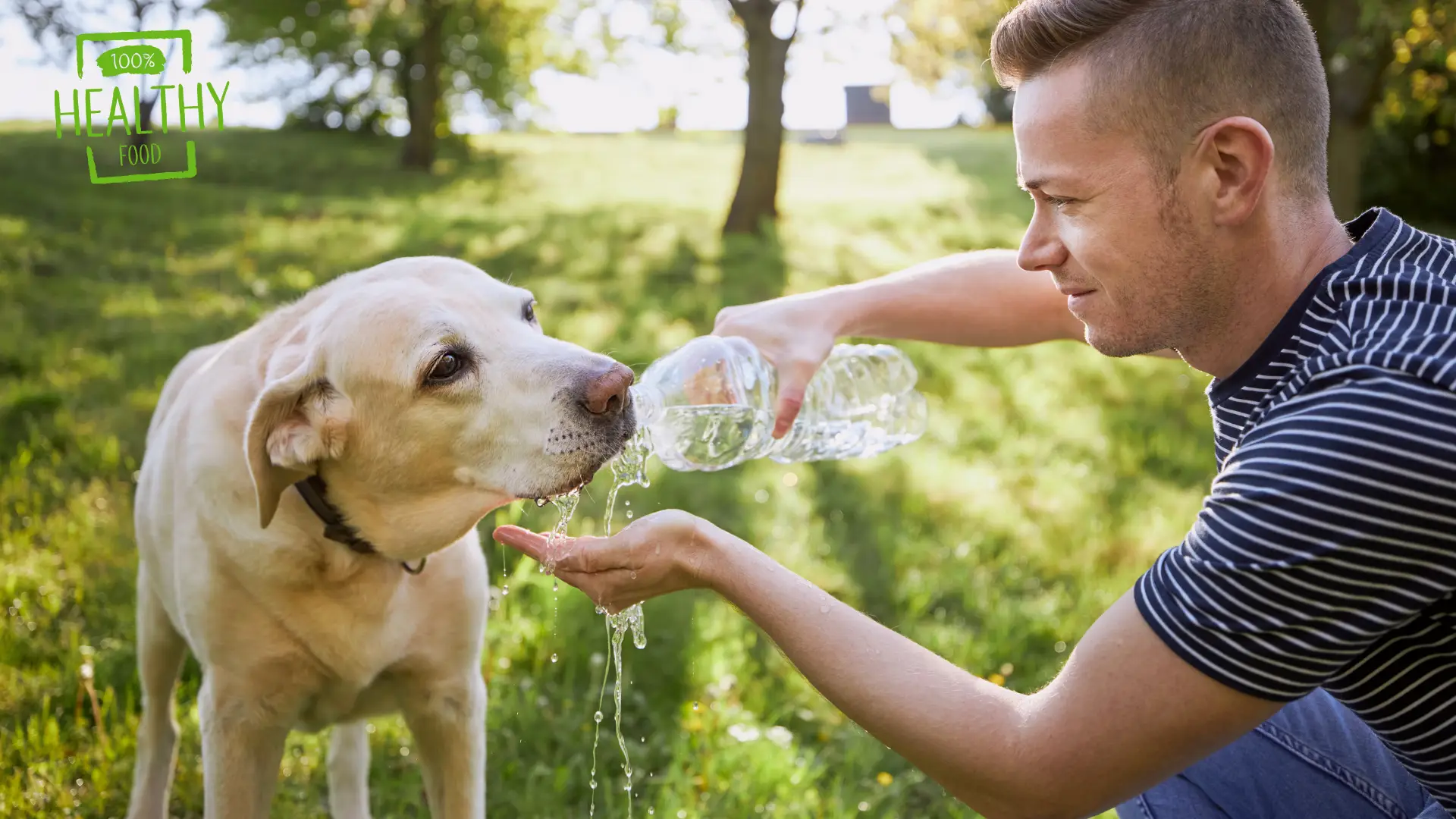
Essential Raw Food Diet Supplements for Dogs – risks and benefits
I remember switching my dog to a raw food diet. I researched, watched the videos, and read all the blogs. Everything sounded perfect—natural meals, shiny coats, more energy, less poop. And honestly, it worked. My pup looked healthier and more alert; his allergies didn’t flare up as much. Raw Food Diet Supplements for Dogs also played a key role in maintaining his health and boosting his well-being.
But a few months in, I noticed something off. He was sluggish, his coat lost its shine, and he started itching more. That’s when I realized raw feeding alone wasn’t enough. Dogs in the wild eat whole animals—bones, organs, fur, glands—all the parts we often leave out. That’s where the real balance comes from.
When we try to recreate nature in our kitchens, we sometimes miss those critical extras—like fish oil, trace vitamins, minerals, antioxidants, or enough phosphorus from the proper bone-to-meat ratio. That’s when things start to slip, and your dog’s health gives you little warning signs.
Over time, I learned what my dog really needed. Fish oil, especially something clean like Nordic Naturals fish oil for pets, brought back his shiny coat and eased his itching. I added raw goat milk a few times a week—it’s full of natural probiotics that helped his digestion. You can even shop raw fermented goat milk (kefir) if you want an easy source. And don’t underestimate simple whole foods like a raw egg, rich in vitamin A, healthy fats, and protein. They do wonders when added wisely.
So, if you’re feeding raw or thinking about it, don’t stop at meat and bones. In this guide, I’ll share the exact supplements I’ve learned to trust—the kind that helped my dog truly thrive.
Let’s dig in.
Essential Raw Food Diet Supplements for Dogs (From One Dog Parent to Another)

Here’s the thing—raw diets are a beautiful start, but they’re not always the whole picture. Over the years, I’ve learned to add key supplements that made a difference in my dog’s health. Below are the essentials I swear by, and trust me, your pup will thank you, too.
🐟 Fish Oil (For Skin, Coat & Brain Health)
- Why I use it: After a few months on raw, my dog’s coat turned dull. Fish oil brought back the shine fast.
- Bonus: Omega-3s help reduce inflammation, boost the brain, and smooth joints.
- What I trust: Nordic Naturals Fish Oil for Pets. It’s clean, has no heavy metals, and dogs actually like the taste.
🦴 Glucosamine (For Joint Health & Aging Dogs)
- Why I use it: As my dog got older, he moved more slowly. Glucosamine gave him his bounce back.
- Best for: Big breeds, senior dogs, and active pups who love to run or hike.
- Natural sources: Chicken feet, green-lipped mussels, or joint-support chews.
🧬 Probiotics (For Digestion & Immune Support)
- Why I use it: Raw food can be tough on sensitive bellies. Probiotics helped my dog’s gut settle down.
- What works best: Raw goat milk is my go-to. It’s gentle and packed with enzymes.
- Want to try it? Shop raw fermented goat milk (kefir) – your dog will love it chilled.
🥚 Eggs (Whole Food Boost with Vitamin A)
- Why I use it: One raw egg a few times a week gave my dog extra protein, fat, and vitamin A.
- Bonus: It’s an affordable, natural source of nutrients—and most dogs lick the bowl clean.
🔬 Trace Vitamins, Minerals & Antioxidants
- Why I add them: Raw feeding can miss small but vital nutrients like zinc, selenium, and manganese.
- What I use: A natural supplement powder with whole food ingredients, not synthetic isolates.
- Extra tip: Rotate leafy greens, berries, and sea kelp for gentle, real-food support.
⚖️ Phosphorus (Balanced with Calcium)
- Why it matters: A good balance of phosphorus and calcium is key for strong bones and kidney health.
- Tip: Don’t feed too much boneless meat. Always balance with raw meaty bones or a quality calcium supplement.
This list didn’t come from a textbook. It came from years of trial, error, and figuring out what helped my dog live better. No two dogs are the same, but these additions are a great place to start.
Essential Raw Food Diet Supplements for Dogs – Real Talk
Feeding raw is awesome, but it is not always complete. After years of trial and error, here are the essentials I trust for my pup. I made this simple chart to keep it easy!
| Supplement | Why It Matters | How I Use It | Pro Tip |
|---|---|---|---|
| 🐟 Fish Oil | Boosts skin, coat, brain, and joints. Raw diets often lack Omega-3s. | Nordic Naturals 3x/week. | Pair with Vitamin E to avoid oxidation. |
| 🌞 Vitamin D | Key for bones, mood, and immunity. Dogs can’t make it from the sun. | 2 egg yolks/week + D3 drops. | Low energy? Check Vitamin D. |
| 🌿 Vitamin E | Protects cells, balances fish oil. | Natural capsule or wheat germ oil. | Don’t skip if using fish oil! |
| 🧬 Probiotics & Goat Milk | Boosts digestion and immunity. | Raw goat milk or kefir 3–5x/week. | Gut gold—dogs love it. |
| 🧂 Trace Minerals | Fills tiny but vital gaps. | Rotate greens, berries, sea kelp. | Whole foods > synthetic pills. |
| ⚖️ Calcium & Phosphorus | Critical for bones and kidneys. | Raw bones or calcium powder. | Don’t feed only meat! |
| 🦵 Glucosamine | Supports joints, mobility. | Green-lipped mussel, chicken feet. | Natural sources work best. |
| 🥚 Egg (w/ Shell) | Mini meal—protein, fat, calcium. | 1–2 raw eggs/week with shell. | Dogs love them! |
| 🔬 Zinc | Supports skin, coat, immune system. | Beef organs or zinc supplement. | Cracked paws? Think zinc. |
| 🌊 Iodine (Kelp) | Needed for thyroid health. | Pinch of kelp powder 2–3x/week. | Check for heavy metals. |
| 🍖 Manganese | Helps joints and metabolism. | Green tripe, chicken feet, mussels. | Sore after walks? Add this. |
❤️ My Advice as a Long-Time Raw Feeder:
- Start slow. Add one supplement at a time and see how your dog reacts.
- Focus on real food first, then support with gentle supplements.
- Don’t chase perfection—watch your dog. Their energy, coat, poop, and mood will guide you.
🐕🦺 How to Choose the Right Supplements (From One Dog Parent to Another)
Be honest, walking into the world of supplements can feel like stepping into a maze. I stood in front of shelves, scratching my head, wondering what’s good for my pup and what’s just expensive fluff. Over the years, I’ve learned what matters most. Before adding anything new to my dog’s bowl, here’s what I keep in mind.
❤️ Stick with Species-Appropriate, Whole-Food Options
Dogs aren’t little humans. Their bodies need different things. I always ask myself: Would my dog get this in nature? If the answer is no, I tread carefully. I prefer real food sources like fish oil, raw goat milk, or kelp. They’re easier to digest and usually better tolerated.
👉 One of my favorites is Nordic Naturals Fish Oil for Pets—it’s clean, third-party tested, and my dog loves the taste.
🚫 Skip the Junk
If the ingredient list looks like a chemistry lab, I skip it. I don’t want synthetic fillers, weird preservatives, or artificial flavors. My rule is: if I wouldn’t eat it, neither should my dog.
💧 Liquid, Powder, or Capsule?
Go with what your dog can handle. My picky eater hates pills but laps up anything liquid. Powders mix easily with raw meat. Every dog’s different—start small and see what works.
🐾 Trusted Brands I Rely On
After trying dozens of products, these are the ones I stick with:
- Animal Essentials – great for herbal and mineral blends
- Four Leaf Rover – clean ingredients, no fluff
- Primal Pet Foods – love their raw fermented goat milk
At the end of the day, the best supplement is the one that works for your dog. Watch how they feel, act, and poop (yes, poop tells you a lot). Go slow. Keep it simple. Your dog doesn’t need everything—just the right things.
🐾 Signs Your Dog May Need Supplements
This isn’t guesswork. These are real signs I’ve seen in my own dogs—little hints they give us when something’s missing in their raw diet. Supplements aren’t magic, but they can fill the blanks when whole food isn’t enough.
🪞 Dull Coat or Itchy Skin
If your dog’s fur has lost its shine or they’re scratching a lot, something’s off. In my case, fish oil made all the difference. I started with Nordic Naturals Fish Oil for Pets—clean, safe, and loaded with Omega-3s. My dog’s coat looked like silk within weeks, and the scratching stopped.
💩 Loose Stools or Gas
A healthy raw diet usually firms things up. But if your dog’s having mushy poops or gas bombs, their gut may need support. I use raw fermented goat milk and rotate in some probiotics from trusted brands like Adored Beast. It works wonders. Their tummies stay happy and poop gets easy to pick up (thank goodness).
⚡ Low Energy or Sluggish Behavior
If your normally bouncy dog turns into a couch potato, it could be a lack of key nutrients—maybe Vitamin D, phosphorus, or trace minerals. I fixed this by adding pasture-raised egg yolks and a mineral blend. I also learned not to skip things like Vitamin A—liver in small amounts helped spark that pep again.
🐾 Slow Healing or Stiff Joints
Glucosamine and green-lipped mussels changed everything for my older dog. His limp disappeared, and he moved like he did as a pup. If your dog takes forever to recover from play or seems stiff, look into joint support—chicken feet, beef trachea, or a natural glucosamine blend all help.
📞 Final Tip: Don’t Guess Alone
If something feels off, listen to your gut—but also call your vet or a canine nutritionist. I did that when nothing made sense. It helped me stop guessing and start healing.
Let me know if you’d like the next section:
🐕🦺 Mistakes to Avoid When Supplementing a Raw Diet

Feeding raw is amazing, but I’ve made some mistakes along the way. Here’s what I’ve learned.
⚖️ 1. Don’t Over-Supplement
More isn’t always better. I went overboard with fish oil and Vitamin A, which caused problems. Too much of a good thing can hurt, so always follow the right dosages and consult a vet if you’re unsure.
💥 2. Introduce Supplements Slowly
At first, I wanted to try everything—raw goat milk, probiotics, you name it. It upset my dog’s stomach. Add one supplement at a time and let your dog adjust before adding another.
🧐 3. Don’t Rely Only on Raw
I thought I could handle everything on my own. But when I got advice from a canine nutritionist, it made a huge difference in balancing things like calcium-to-phosphorus. Don’t skip expert guidance when needed.
FAQs: All About Raw Food Diet Supplements for Dogs
I add fish oil (Omega-3s), probiotics (gut health), glucosamine (joints), and vitamin E (skin). Focus on filling nutritional gaps.
Yes. Even the best raw diets can miss key vitamins and minerals like calcium. Supplements help ensure complete nutrition.
Dogs need proteins, fats, vitamins, and minerals—especially calcium, phosphorus, Omega-3s, and B vitamins. Always check with your vet.
I follow the 80/10/10 rule: 80% meat, 10% bone, 10% organ. Mixing meats and organs helps keep the diet balanced.
Yes! Probiotics help digestion, especially on raw diets. I use Adored Beast Probiotics and noticed great results.
Fish oil, glucosamine, kelp powder, and probiotics are my go-to choices to cover common nutritional gaps.
It means feeding 80% meat, 10% bone, and 10% organs. This keeps your dog’s diet naturally balanced.
Add high-calorie options like raw eggs, bone marrow, goat milk, or healthy fats like coconut or salmon oil.
Definitely! Supplements like fish oil, probiotics, and glucosamine help maintain health and fill any nutritional gaps.
Yes, they can! (Check out my full guide on it.)
These answers are based on my experience. Always check with your vet for personalized advice.
Conclusion: A Balanced Raw Food Diet Supplements for Dogs
From one pet parent to another, I can tell you that feeding your dog a raw diet has been one of my best decisions. It’s incredible how much my dog’s energy, coat, and overall health have improved. But let me tell you, it’s not just about the raw food itself—it’s about ensuring your dog’s diet is complete, which is where supplements come in.
I’ve learned the hard way that a raw diet alone doesn’t always cover everything they need. That’s why I add things like fish oil for a shiny coat and healthy joints, or probiotics to keep their gut in check. For some dogs, a little raw goat milk can make a big difference, especially when it comes to their immune system. Glucosamine has been a game-changer for my dog’s joints too. It’s all about finding what works best for your dog.
Every dog is unique, and what works for one might not work for another. Over the years, I’ve realized that paying close attention to how my dog reacts to different supplements is key. It might take a bit of trial and error, but it’s worth it.
If you’re ever unsure about what your dog needs or how to balance things, don’t hesitate to consult with a vet or pet nutritionist. They can help you make sure your furry friend is getting everything they need to thrive.
I hope you’re feeling more confident about giving your dog the best with a balanced raw food diet. Your dog will thank you for it, trust me. If you have any more questions or want to learn more, I’m here to help!



